In 1983, Utah was the first state to lower the level of blood alcohol content that would qualify for a DUI arrest when they went from .10 to .08. Then Oregon followed suit.
Now we’re poised to follow Utah again as the second state to reduce the DUI limit even further to .05.
That’s the intention of a bill (PDF) that’s been introduced by Oregon Senate President Peter Courtney, which is still in draft form until the legislative session formally begins next month.
A one-pager (PDF) released by Sen. Courtney’s office, says Senate Bill 7 follows a 2013 recommendation by the National Transportation Safety Board (NTSB) that all states adopt .05. The NTSB reports lowering BAC limits from .10 to .08 led to a 10.4% reduction in alcohol-related fatalities between 1982 and 2014. They also estimate a lowering to .05 would save 1,790 lives a year.
Advertisement
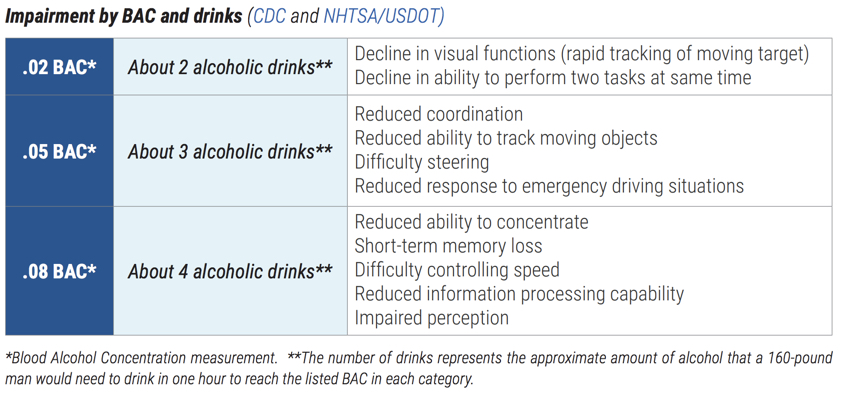
Below are the selling points of this legislation as per Sen. Courtney’s one-pager that’s making the rounds to safe streets advocates and Oregon Department of Transportation (ODOT) staff (note, they were drafted before Utah passed their law):
• BAC limits have been changed before, and fairly recently. Oregon and Utah were the first states to move from a 0.10 to 0.08 in 1983, Delaware was the last state to adopt 0.08 in 2014.
• Many countries have enacted a .05 BAC limit, including Australia, most of the EU, Hong Kong, Israel, and South Africa.
• A 160-pound man would have to drink 4 alcoholic drinks an hour to reach a BAC of 0.08, verses 3/hour to reach 0.05.
• Drivers with a BAC of 0.05-0.79 are 7 times more likely to be in a fatal crash than drivers with no alcohol in their system.*
• According to the NTSB, lowering BAC limits from .10 to .08 reduced annual alcohol related fatalities by 10.4% nationwide. NTSB estimates a reduction from .08 to .05 would result in an 11.1% decline in fatal crashes.*
• Decreasing BAC limits does not reduce average alcohol consumption.*
In a phone interview with Sen. Courtney this morning, he said the growing distractions inside cars and the prevalence of alcoholism in his family influenced his thinking on the issue. “I’ve had alcoholism on both sides of my family, I fear it more than any other drug,” he said. “I don’t need any studies on this. I grew up with it. There’s this attitude you can drink and drive. You have no damn business behind the wheel if you’ve been drinking. I don’t want to hear it. If you drink, fine. But you better have plans to not drive. You better start walking. You better call an Uber or Lyft.”
The bill as currently written would make one simple amendment to ORS 813.010, changing every instance of “.08” to “.05”. Utah just passed a similar law that goes into effect December 30th.
Lowering Oregon’s BAC level has been a goal of ODOT for years. It’s currently listed as a “Tier 1” priority in the state’s Transportation Safety Action Plan (PDF). That plan reports impaired driving (alcohol and/or drugs) was a factor in 22 percent of all fatal and serious injury crashes in Oregon between 2009 and 2013. That equates to 625 fatalities and 1,087 serious injuries.
And yes, in Oregon bicycle riders can be arrested for DUI.
Lisa Taylor, an assistant legislative director in Sen. Courtney’s office, says they’re seeking public feedback on the bill. She can be reached at (503) 986-1604 or at lisa.taylor@oregonlegislature.gov.
Another place for feedback and debate about this bill will be the Governor’s Advisory Committee on DUII, whose mission is to, “… Generate public support for increased enforcement of state and local drunk-driving laws. Educate the public as to the dangers of driving while under the influence and its effects on life and property.” Their next meeting is on January 4th in Salem.
Sen. Courtney downplays the chances of the bill. “I’m a laughingstock for this. I doubt it will get a public hearing.” He said he expects major blowback from the restaurant and alcohol lobbyists. “That industry is going to fight this, because that’s how they make a living.”
— Jonathan Maus: (503) 706-8804, @jonathan_maus on Twitter and jonathan@bikeportland.org
Never miss a story. Sign-up for the daily BP Headlines email.
BikePortland needs your support.



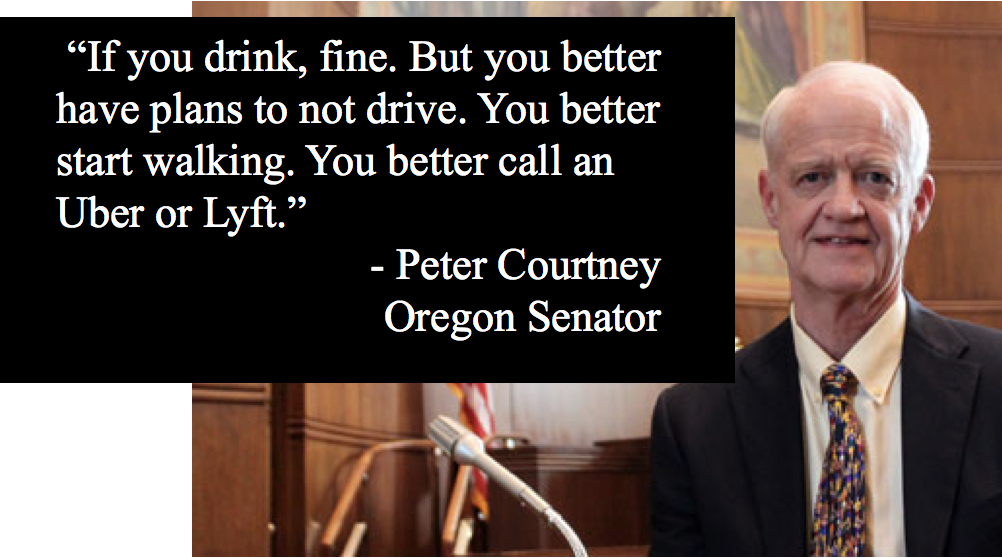

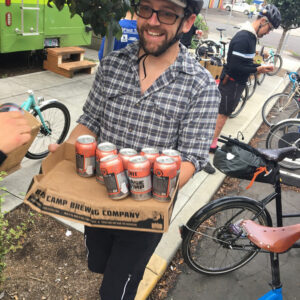
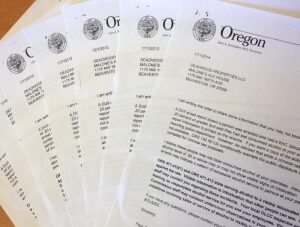
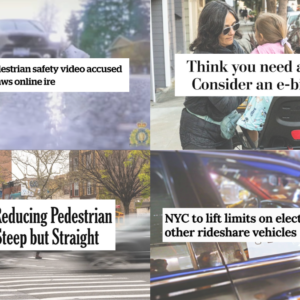
Thanks for reading.
BikePortland has served this community with independent community journalism since 2005. We rely on subscriptions from readers like you to survive. Your financial support is vital in keeping this valuable resource alive and well.
Please subscribe today to strengthen and expand our work.
Is there any evidence that a cyclist is more likely to kill someone at 0.05 than at 0.00? While I am not sure that I think that lowering the limit for driving will actually reduce the amount of drunk driving it does seem like there is at least evidence that driving when you have a BAC over 0.05 is dangerous to others I have never seen any such data for cycling. Perhaps this is a moment to finally remove or significantly reduce the criminal penalties for cycling after a couple of beers since it is very clear that it is much more dangerous to drive a car after drinking than to bike.
If it saves one person from being injured by a cyclist, where is the harm?
Sorry – but I had to recycle that argument I have heard before.
The harm is if they are treated the same, then it removes the incentive to ride instead of drive. Someone might then drive their car instead of riding a bike. I know I’d much rather be hit by a drunk person on a bike than a drunk person driving a car.
This law is a direct result of the perverse interaction between vehicular cycling ideology and the pervasive prejudice of the automobile majority.
The idea that riding a bike is remotely comparable to driving a 3-10 ton metal box is farcical.
Riding drunk is not a victimless crime.
Who said it was?
Yeah it basically is, drunk cyclists kill people so infrequently it is hard to even find data on so it is ridiculous to have the penalty be the same for biking at 0.05 as driving at 0.4 but that is exactly what this bill would do. You might as well say that pushing someone is the same as shooting them. Sure they might fall and hit their head, but no one would actually choose getting shot over getting pushed and we dont punish people the same for shoving someone as we do for shooting someone. I am not saying there should never be any penalty for BUI but pretending it is as dangerous as DUI is silly.
Sure; a cyclist who gets in a bad crash because they were drunk is victimless in the same way someone who commits suicide by jumping in front of a train is victimless. No one hurt but the cyclist. And their family. And their friends. And the driver. And anyone who has to deal with the trauma. And…
And I agree — pretending drunk biking is as bad as drunk driving is silly.
Cyclists, drunk, stoned or stone cold sober kill so infrequently it’s difficult to get data. Basically the victims are old people who die from head injury for almost every reported case I can find. Another point for mandatory pedestrian helmets. /s
I know it’s a thought exercise, but I wonder how this argument would go if a majority of people were riding bicycles instead of driving – like in the post-happy motoring oilocolypse scenario. Those riding their bikes drunk would represent a danger to others by elevating the risk of crash. I don’t need studies to tell me that alcohol impairs a person’s ability to ride. Though bike-bike crashes are less severe, they can still cause broken bones, concussion, property damage, and worse. While I too would rather see people riding their bikes drunk than driving drunk, the safest option for everyone involved is either walking or letting someone else pilot a vehicle that carries the impaired person.
I like thought experiments like this.
I think we’d learn several things.
(1) bikes ridden drunk are far more dangerous to their drunk riders than to anyone else
(2) injury and death rates from BUII would be far lower than from DUII
(3) better not to drink at all, or if, then to stay put.
As AJZ reminded us, the drunk pedestrian is a scourge from which he hoped to save us.
Interesting thought. Is it safer overall for someone to take an Uber than to ride their bike with a buzz on at the end of the night? If I am also riding at night, I think I would still prefer the buzzed cyclist than the Uber driver.
The assumption that walking while intoxicated has lower risk than cycling while intoxicated is dubious.
* 34 percent of pedestrians killed had a blood alcohol concentration of 0.08 g/dL or higher.
* 31% of drivers killed had a blood alcohol concentration of 0.08 g/dL or higher.
* 19 percent of bicyclists killed had blood alcohol concentrations of 0.08 g/dL or higher.
https://crashstats.nhtsa.dot.gov/Api/Public/ViewPublication/811870
http://www.pedbikeinfo.org/data/factsheet_crash.cfm
These figures don’t account for differences in the proportion of users of each mode that are drunk, though.
Since walking is probably the preferred mode of transport for drunk people (given legal repercussions and the perceived danger of biking while intoxicated), it seems reasonable to assume that the ratio of drunk pedestrians to total pedestrians is a fair bit higher than the ratio of drunk cyclists to total cyclists. If this is true, then then the statistics you site could still be true even if cycling while drunk was significantly more dangerous than walking while drunk.
For example, if 5% of cyclists are drunk and 15% of pedestrians are drunk, even if the risk of cycling while drunk is twice that of walking while drunk, then (if we assume, for the sake of clarity and isolation of variables, that sober walking and cycling are equally safe) a greater percentage of dead pedestrians will be found to have been drunk in comparison to cyclists.
My intention is just to show that the statistics you cite don’t, by themselves, establish anything about the relative dangers of walking vs cycling while drunk—and so they don’t really cast much doubt on the claim that drunk cycling is more dangerous.
I agree. Those stats Soren cited are of dubious value here since I would assume that most of those who ended up dead but we’re not in a car were killed by someone driving a car, which brings us right back to square one. AJ Zelada used these stats to make a very convoluted case (see link below) against drunk pedestrians and drunk cyclists too. I did not find his argument particularly persuasive then, and am not here either.
https://bikeportland.org/2014/10/31/vision-0-08-major-safe-streets-effort-must-tackle-alcohol-112928
Another link, interrogating the drunk pedestrian matter:
https://bikeportland.org/2014/10/31/vision-0-08-major-safe-streets-effort-must-tackle-alcohol-112928#comment-6918881
“Set aside the fact that there is no legal BAC limit for pedestrians because the act of walking is inherently harmless. The data actually shows that drunk victims are a smaller share of total pedestrian fatalities today than they were in 2014. […] In other words, the increase in pedestrian fatalities is clearly not “fueled by people who walk while drunk.””
i am responding to a claim that drunk cycling is more dangerous than drunk walking (made with ZERO supporting evidence).
“statistics”
no statistics were presented. what was presented was a real world counterfactual. if the inherent risk of cycling drunk is so small that it would not have an appreciable impact on the real world risk factors (causal or confounding) then perhaps this hypothetical risk is irrelevant.
FWIW, my hypothesis is that cycling drunk is inherently safer than walking drunk because of an important confounding factor: cycling has a higher motor skill barrier than walking.
I think the question has more to do to whether a drunk pedestrian poses more harm to others than a sober one, not whether they themselves are more likely to be injured or killed. These statistics don’t indicate any trend in that direction, though I imagine in increased risk posed by a drunk pedestrian is marginal at best.
If you say that a bicycle is a piece of equipment permitted to roll on the highway, same as a wagon, no license plate, one human-power, one horse-power, whatever, it’s technically legal to operate but you really want to pay attention, if you get sauced and you get crossed up with a bus or a semi, it’s going to be pretty brutal and one-sided, and you’ll die on-scene, probably. A car is a little different animal, goes faster, can do more damage than you on your Schwinn. A pickup, that bus, the semi truck, they can REALLY do some damage if misguided, and if you’re drunk, that’s what you are, is a misguided missile. Unfortunately this legislation proposal is also misguided, what really needs to happen is that current standards need enforced, and there has to be enough jail and prison beds and impound yard spaces to accomodate that. Actually enforce the .08, but also while you’re at it, expand the understanding of ‘being impaired’ to include illness, prescription meds, fatigue, emotional upset, texting, and so forth. Why so strict? Because everyone’s life on the highway depends on YOU doing YOUR job as operator, from bicycle on up, and hey, while we’re at it, you jaywalkers, too. If you stumble out in the road, half-in-the-bag, and someone has to lock the irons to stay off of you or they veer into the other lane and cause damage, you should be in front of that judge owing up for your part of things. And we don’t want to hear any ‘incompetent because I was intoxicated therefore not responsible for my actions’ type stuff out of you, either. If you were judged incompetent prior to the incident it probably means someone else was assigned to your care and you wandered off and somehow had beer money or something. But, that’s different, and they’re going to jail instead of you for negligence, probably.
Under the influence now also includes things like LSD, video games, probably going off of required prescriptions, and declining health. Low blood sugar can kill you, and others, so know where you’re at with all of that. If you’re not fit to operate, then don’t. Call that taxi, hop a ride with a friend, take the bus. Anything’s better than that ambulance ride, for you or for someone else. Bicyclists that think they own the road, you, too. Ego’s a thing. Know the dangers.
I can see a drunk cyclist making an illegal crossing or serve into traffic causing a car to serve to avoid or sudden stop. This chain reaction can cause serious harm or death. There are plenty of people who lose their lisence and use a bike to go to a bar, get drunk, and then ride back home on their bike drunk. Good chance that drunk bicyclist is fine but that car next to it is another story.
This is great. Commercial drivers have long been held to a 0.04% BAC standard and since class C vehicles keep getting bigger and heavier, it’s high time (ahem) to upgrade the standard.
We could use an additional change to our drunk driving laws. Currently, convicted drunk drivers get one freebie per decade. Especially in an era of lax enforcement, this is a grave error. We need to incorporate the retraining these drunk drivers get into the initial licensing program and get rid of the freebie.
Diversion isn’t really a freebie. And it’s once every 15 years
You have to be careful these continual efforts to push the levels lower and lower. Remember that there is a whole DUI industry that the state profits from. Lowering the standard is just creating a larger tax/fee base rather than specific increases in public safety. I would advocate for all fines collected from this rule change be allocated to charities and all fees subject to independent review, thus making it revenue neutral to the state.
It sounds like you want us to set aside all the past evidence from the .10 to .08 change, the experience of other countries currently at .05, and the research-based projections of impact that say that many lives will be saved. Instead, you think we should work to hold the infamous and sprawling DUI industrial complex at bay. Am I reading that right?
Maybe you’re playing reverse psychology here, because I think you’ve just helped me be even more certain that I support Senator Courtney’s efforts.
You have a problem with the government funding police by fining people that endanger others by driving drunk?
Personally, I have no problem with this policy. If we can hire more officers and step up enforcement by lowering the level to .05, that’s just more lives saved.
Beaverton PD posts the average BAC level each month.
Nov – .12
Oct – .15
Sept – .14
Aug – .14
Jul – .17
With the average being so far above the threshold, and about 1-1.5 arrests/day, it’s impossible that many drivers are busted for driving at 0.08. Since the current limit isn’t being enforced, I don’t see any reason to believe that a lower limit would have a measurable effect.
I grew up in a land where drinking a six’er and then driving across town was the norm. It was only in college that I realized and learned that .08 BAC was easily reached. Given my desire to not want to get arrested, I quickly curbed that behavior. A move from .08 to .05 would further change my behavior, as it would with many others. This is a smart move that would detour ‘some’ DUI driving, but as you state, it would likely not touch the belligerent drunk drivers out there. Some is better than none when it comes to keeping our streets safer.
And to go farther, do we know how many drivers were pulled over on DUI suspicion, only to blow a 0.05 or lower and be released? I bet not many.
“Honest officer, I’m not drunk. I was just texting my girlfriend”.
I’m not drunk. I’m stoned!
In Oregon if a cop believes you to be intoxicated they can charge you with DUI even if you blow 0.00 and it does happen. It was very common in Corvallis when I lived there. This change would make it automatic, but today if you blow 0.05 and failed the field sobriety test they are already probably going to be charging you with DUI.
I certainly would like to see a graduated punishment system, based on the danger someone poses, factors might include if you have done it before as well as how drunk are you. There is a pretty big difference between 0.08 and 0.4, but not in the eyes of the law… To me if you are over 2x the limit I am not sure that diversion makes sense any more than if it is your second dui within 10 years.
A fine multiplied by vehicle curb weight. $1 per lb. This would be on top of current fines, diversion, prison time, etc.
I’d second that. IMO, the standard for operating a vehicle impaired should be the same for drivers and cyclists, but the consequences between the two are vastly different (4000lb vehicle going 60mph /= 30lb bike going 12mph). Same threshold, but different penalties.
I welcome any legislation that has the potential to cause drivers to have a greater fear of law enforcement.
Since there is almost no enforcement of traffic laws and since DUII convictions produce almost no reduction in drunk driving by the guilty, I’m not sure what this would actually accomplish.
Exactly. None of this matters unless there is enforcement…and there are not enough cops to do this, not as they are currently allocated.
I’m concerned with repeat DUII offenders. It is my understanding that our laws and/or how we enforce them permits/anticipates repeat DUIIs, but that there are jurisdictions that levy harsher penalties than we do here in Oregon. Penalties that make repeat DUIIs less likely or punishable with increasingly onerous sanctions. Am I wrong?
I do not believe you are.
Just off the phone with Senator Courtney and updated the post with his comments:
I am for these changes but they lead to an additional problem with enforcement. Since we don’t have roadblocks, apprehension of drunk drivers ( unless they crash) is dependent on police officers observing erratic and dangerous driving behavior and then pulling the driver over using this observation as cause. But from what I have seen, so many of the current motorists on the street drive in an erratic and dangerous manner all the time. Arn’t the police gonna have a hard time “picking the wheat from the chaff” as they say on the farm?
As long as it goes after weed users too.
And prescription medication users and the elderly, people missing limbs, the deaf, as well as people who fall below a certain level of intelligence and critical thinking ability. There are a lot of reasons for people to not be driving, alcohol intoxication is just one of them.
Except that evidence that marijuana use is associated with increased risk while driving is contradictory and relies on low quality studies. It’s an open question whether recreational use of marijuana is associated with unsafe driving*.
A systematic review:
https://www.ncbi.nlm.nih.gov/pmc/articles/PMC2722956/
*I do not used marijuana and have absolutely no interest in doing so.
This is so bad and … will fail to accomplish anything good. Attempted DUII is already a crime in Oregon. Won’t stop anybody. Won’t change behavior. Just creates a lot of new criminals for the one size fits all criminal-industrial complex.
Ignition interlocks are incredibly inexpensive and MADD proposed that they be made mandatory decades ago. The idea that we need more “enforcement” is nothing more than apologia for drunk driving.
Exactly. We should throw out all of our criminal code. People are still murdering out there. Clearly our laws against murder are not working.
https://bikeportland.org/event/welcome-to-bike-portland-2
And drinking was encouraged for this event.
Double standards get old.
I agree that comparing the risk of someone cycling drunk killing someone (negligible) versus the risk of someone driving drunk killing someone (far too high) is the epitome of a double standard.
https://www.cdc.gov/motorvehiclesafety/impaired_driving/impaired-drv_factsheet.html
More moral relativism from Soren!
I’m not sure about that, but I’m pretty sure he is correct,
You could also think of it as drunk people with forks vs drunk people with firearms. Are we really going to get hot and bothered about drunk people wielding forks, when drunk people with guns cause so much mayhem we don’t even know where to begin?
https://www.ncbi.nlm.nih.gov/pmc/articles/PMC4762248/
The absolute horror of morality that is not based on (religious/nationalist) absolutism!!!
The city with the most deaths by cyclists in the US is NYC. The ratio of all deaths from cyclists to drivers driving on sidewalks in NYC is about 1:50. Given that ratio combined with the large number of sidewalk drivers with >0.08% BAC, making BUI anything more than a minor ticket (combined with the difficulty operating a bicycle while legally intoxicated) is just a waste of LEO resources.
Which brings up another point: it is almost impossible to ride a bicycle while legally too intoxicated to operate a motor vehicle due to impaired balance. The problem is (mostly) self-correcting.
I disagree with the “impossible to ride a bicycle…” statement.
Once we’ve dealt with all the rampant mayhem in our society it’ll be time to deal with people riding bicycles drunk. It’s stupid to have that law because cops won’t write the ticket unless they are mad at you for some other reason. Anecdote: I’ve heard of a person passing out drunk, falling off their bike, and the cops who found them moved the debris to the sidewalk, checked vitals, and said good night.
Oh, man. You got him good. Give yourself a big pat on the back.
Peter is deflecting on his poor record on equality and providing a harassment free workplace. https://www.seattletimes.com/seattle-news/sexual-harassment-scandal-reignites-at-oregon-capitol/
This is man bites dog story.
I support lowering the BAC to 0.02, but I question the data at the top that suggests that you can drink 2 alcoholic drinks/hour and be at 0.02. Advertising in Australia (limit 0.05 for unrestricted license holders) said it would be three drinks in the first hour to get you over 0.05 and one an hour to keep you there – the ads say “rethink your third drink” for men, and “rethink your second drink” for women. 0.02 is used in Australia for probationary drivers and in Japan for all drivers – it basically takes account of the alcohol present in your blood stream as a result of fermentation of sugars in the gut. I favor the 0.02 limit because I don’t want people trying to count their drinks, everyone’s metabolism is different, so the safest assumption is that if you’re drinking or using drugs, you’re not driving or operating other potentially dangerous equipment.
I spent the first 38 years of my life living in Australia, apart from a one year sojourn in New Zealand. State and territory governments in Australia, and the government in NZ take an extremely dim view of impaired driving, and use random breath testing to rigorously enforce the laws. There are no second chances, a first offense will see you hit with a fine and a three month suspension – subsequent offenses can see your license cancelled and you may receive a custodial sentence. The impaired driving laws apply equally to all intoxicants, and all vehicles, although I’ve never seen a bicyclist pulled over by an RBT stop. The governments in Australia and NZ are ultimately responsible for picking up the tab for injuries caused by impaired motorists, so they have strong vested interest in keeping impaired drivers off the road. Speed and red light cameras are used extensively as well. The judiciary supports the governments’ policy positions to keep the roads as safe as possible, so creative arguments about civil liberties receive short shrift in Australian/NZ courts.
My own view is that if you are consuming intoxicating substances, you have no business operating a motor vehicle on the public streets as you are a danger to yourself and others road users. As the government may end up having to support people who are injured through their own recklessness, I am inclined to support the public policy position that the government has a vested interest in stopping people engaging in very dangerous behaviors, such as cycling on roadways shared with motor vehicles while intoxicated – I am less concerned about people cycling drunk on MUPs.
As I recall (Utah culture aside), the 0.08 standard for DUII was a Federal ‘suggestion’ that tied future funding to compliance.
While I agree drunk driving is more dangerous than drunk cycling, I fully support this bill. It’ll make streets safer for everyone.
“It’ll make streets safer for everyone.”
Do you have a citation (or any evidence) for this claim?
There is plenty of evidence that lowering the BAC to .05 will reduce crashes. You might start with the NTSB report cited in the article.
***portion of comment deleted*** my comment referred to this:
“drunk cycling”
You cited “It’ll make streets safer for everyone” with your request for evidence. Don’t get angry with me for not knowing you were actually responding to something different, which isn’t event the topic of the bill that Greg Spencer was expressing support for.
Exactly, the supporting data is there in the article. We might quibble with the fact that the law doesn’t discriminate between drunk cycling and drunk driving. But that’s a battle for another day. The priority should be reducing drunk driving and this bill would do that.